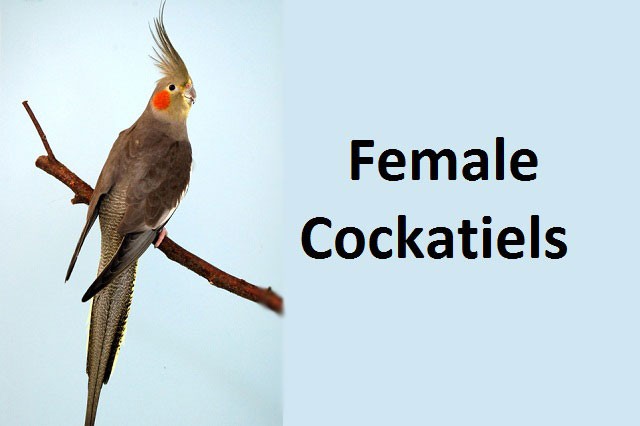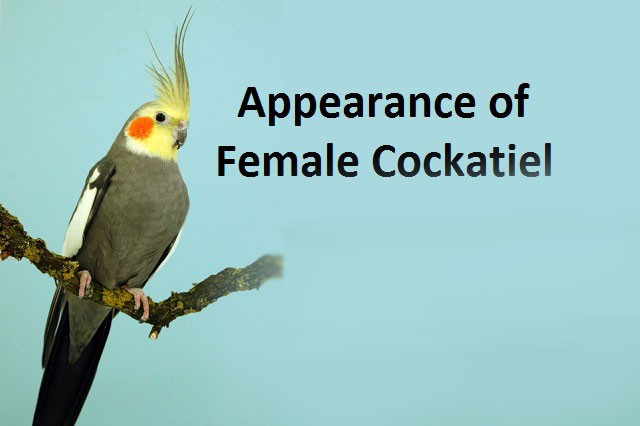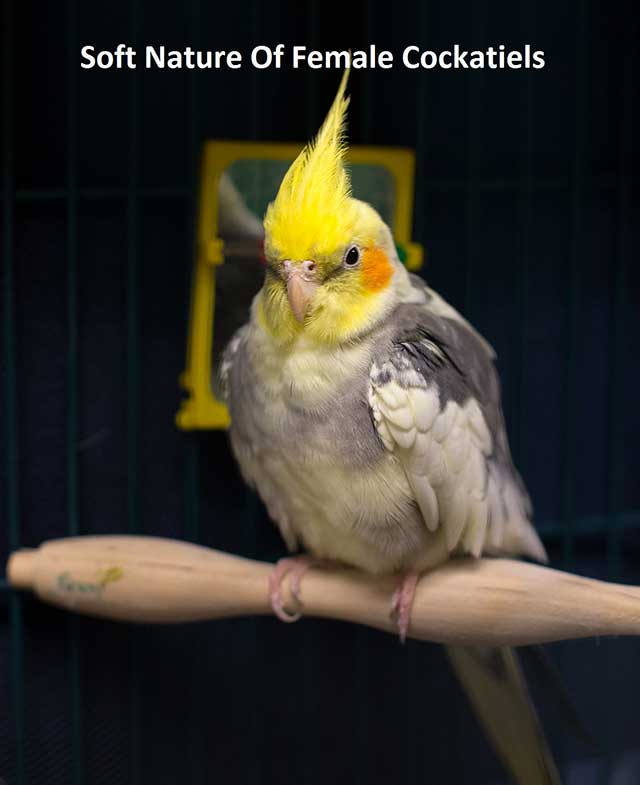Female Cockatiel parrots originate from Australia. They belong to other parrots such as Galah and cockatoos.
Mature male and female cockatiels having a grey body and yellow head are nearly easy to differentiate them sexually by their plumage.
Male and female cockatiels seem alike, therefore, it is complicate to determine the sexual difference.
Cockatiel parrots will specify male and female cockatiel after their first molt at approximately six to nine months of age. At this age, the mature cockatiel colors show.
Female Cockatiels

Now, this article will mainly comprise all possible knowledge about female cockatiel parrots. Female cockatiel behavior and especially their mating behavior will be focused.
You will get to know about female bird sounds with respect to their mating sounds will be discusse.
Make your concepts clear about female cockatiel takings and the female cockatiel sounds which show female bird mating behavior by studying this article.
Some ideas about cockatiel feeding guide with proper and healthy cockatiel diet tips should be briefed.
Let’s start this piece of knowledge with some modes to determine a female cockatiel.
The Appearance of Female Cockatiel

The appearance of a male and female cockatiel is the same when young.
After their first molt which will be after 6 to 9 months of birth, their body tends to grow a new layer of feathers. This covering is very colorful and is different among male and female.
Some breedings of female cockatiels retain their young grey or brown color of the face.
In the cockatiel parrots having white face cockatiel mutations with colorful bodies, females have unclear cheek patches that resemble their body feathers.
Cockatiel breedings which have grey body feathers, their female cockatiels have light grey plumage.
In some cockatiel breedings, female cockatiels carry light yellow patches on the bottom of the wings.
In pearl cockatiel mutation, female retains their pearling after their first molt.
The female cockatiel of normal grey cockatiel mutation has light-colored orange dots. They have reduced yellow and grey color on the back.
Some normal grey female cockatiels have spots or random arrangements on the grey back.
Mature normal grey female bird have patches on the bottom of their tail feathers. These patches may be in the form of parallel lines of (dark/light) grey or yellow color.
These patches are often horizontal stripes alternating grey/dark grey or white/grey or yellow/grey, but some females have dots or irregular patterning on a grey background.
The Lutino Cockatiel breedings or pale yellow and pale white cockatiels having cheek spots, females have yellow markings under the wings and yellow markings below the tail. Lutino Cockatiel Types females are looking very beautiful.
Soft Nature Of Female Cockatiels

Female cockatiels have very soft and elegant behavior. Usually, they are reasonably quiet.
Female cockatiels are more likely to be kind and not as care seeking.
Talking and Whistling Of Female Cockatiels
Naturally male cockatiels have a good status catching up sounds better than female cockatiels.
Since male and female cockatiels have the ability to whistle naturally, this is the part of showing their courting behavior.
But female cockatiels are not recognized for their talking and whistling behavior.
These small parrots are high in temperament and are fairly tamed like all other species of parrots.
Male cockatiels tend to better whistle or cry, while females do screeching.
Males are better in vocalization than females.
Female cockatiels see the male cockatiels and give comments on their performance by granting them with consideration.
This is the female cockatiel mating behavior.
Female cockatiels have the ability to talk and some do. As compared to females, male cockatiels are more talkative.
Female Cockatiels can give you a loud shout when you leave them alone.
They may talk to other cockatiel parrots in the neighborhood but like to stay much quieter than the male cockatiels.
This female cockatiel behavior makes male cockatiels better pet than females.
Sounds of Female Cockatiel

Female cockatiels can make simple cockatiel sound of “wheeeeeeep”.
Some pet female cockatiels sounds are as under.
- an irregular chirp
- whistle copied again and again
- a deep, extended wolf whistle
- a sharp screech
- rhythmic tweets
- a minute whistle melody
- a light squeak during dozing.
These are all female cockatiel sounds.
Egg Laying Problems Of Cockatiel
The egg laying is only found in female cockatiel parrots.
A female cockatiel can lay eggs when kept alone. But these eggs are not fertile and are not likely to produce chicks.
Normally a female cockatiel lay one egg daily until a clutch of five eggs has completed.
If you want to prevent this behavior of female bird, enable her to sit on these eggs for roughly 10 days before getting them apart.
Whether you quickly take the eggs apart, she will resume generating more eggs. Control more nesting by decreasing her times of daylight from 10 to 12 hours. Albino females are very good in nesting.
Breeding Process Of Female Cockatiels
The cockatiel breeding time is an attack of hormonal disturbances, especially for male cockatiel parrots.
Female cockatiels also face hormonal changes throughout the cockatiel breeding season.
The valid period for the cockatiel breeding is middle of September from August. Breeding clutches produce through this season of breeding are very good.
Cockatiel Breeding can also be taken throughout the month of March but the eggs and the chicks are not healthy enough.
This breeding of cockatiel can transmit constant influences on the male and female cockatiel parrots.
Female cockatiel parrot will keep in the cage 7 to 8 days before she will start egg laying. By doing this, a female cockatiel will become intimate with the nesting area.
Female cockatiels will usually lay eggs after 18 days of breeding.
Birds Cage accessories and DIY bird toys play a vital role in the cockatiel breeding process. Birds swing are also imported in the crossing of cockatiel parrots because if they are not stable, cockatiel parrots cannot cross properly.
2 or 3 bird perches should be placed for the refreshment of female cockatiel parrots for crossing.
Female cockatiels have flexible pelvic bones. This flexibility of pelvic bone is for the passing egg in females. It is also the main factor of cockatiel breeding.
They are comparable to human beings in this situation because human females also have soft and broader pelvic bones.
A regular and healthful male and female cockatiel parrot is mature sufficient for breeding at the age of 18 to 24 months.
Nesting Of Female Cockatiels
A female cockatiel tries to find out a hidden place, surrounded area for nesting, like the corner of a cupboard or in the back of accessories.
Therefore, make certain to keep these areas out of limits.
Incubation Process
The incubation period of Cockatiel parrots is usually of 17 – 21 days. As the incubation period starts, male and female cockatiels distribute egg incubation and chick-raising responsibility.
Likewise, a male cockatiel held as a single male may take a tiny thing as his “egg” and lie on it as well as maintaining his nesting region actively.
Health Problems Of Female Cockatiels
Here we are going to discuss some female cockatiel health problems that might be severe in some birds.
- Egg binding: Normally it is in the case of those females in which the amount of fat is increased.
- Throwing of Egg: Usually, a female cockatiel parrot throws her eggs apart because of unsuitable atmospheric conditions. She does this also if the eggs are infertile.
- Lack of Calcium: lack of calcium is because of continual clutches after a precise duration of time.
- Plucking of Feather: Because of the lacking of calcium in female cockatiel parrots, they started to pluck the feather of their chicks. This will help them somehow to complete deficiency of calcium.
- Egg laying weakness: Female cockatiels become weak day by day because of repeated breeding in a short period.
- Stop to egg laying: Female cockatiel parrots stop to produce eggs because there may be a tumor or lump in their reproductory track. Another reason is the massive amount of lipids or fats in the body.
These are some health problems usually very common in Common White female cockatiels. If you live in NY and you have any kind of pet related issue and you want to check exotic animal vet then you can go here.
Care And Feeding Of Female Cockatiels
Female cockatiels should be provided with the best cockatiel diet for healthy and strong breeding. The female cockatiels like to eat a variety of seeds, berries, fruits and veggies.
Female Cockatiels are especially expose to obesity, iodine deficiencies and some additional diet-related problems such as feather plucking and egg binding.
So, female cockatiel should be provided with a balanced and mixed cockatiel diet for proper breeding.
During the breeding process of cockatiels, female cockatiels should be provided with sunflower seeds, canary seeds, protein-rich fruits and vegetables.
Egg food is the most nutritious food which is provided to female cockatiels during breeding. Egg food is a mixture of hard-boiled eggs with its shells mashed with soaked bread.
It is enriched with proteins and essential for a female cockatiel.
So, female require food which contains a huge amount of calcium. To complete the deficiency of calcium, egg shells also, given to female cockatiels during breeding.
When female cockatiel is sitting on chicks she requires soft which is easy to digest. Cockatiel chicks can also eat bread as soft food.
Harrisons cockatiel food and Zupreem cockatiel food are one of the best cockatiel food brands. They provide the best nutrients which are required for a cockatiel breeding pair.
Make sure to plan the best cockatiel feeding guide during the breeding process. It will be very helpful for producing a healthy clutch of eggs.
Summary
In this article, we have discussed all the facts about female cockatiels which are helpful in cockatiel breeding.
The appearance of female cockatiels in various cockatiel mutations have been discussed properly.
Hopefully, you have enjoyed after studying the soft and gentle behavior of cockatiel parrots. Female cockatiel sounds and talking have explained well in this article.
You have also seen the egg-laying problems and the requirements of egg laying in this article.
The whole process of female cockatiel mating behavior, mating sounds and the breeding process have been described.
From nesting to the incubation process as well as the health problems of female cockatiels have also discussed.
You have also studied the care and feeding of female cockatiels. Cockatiel feeding guide which is important in the breeding process has given efficiently.
{ "@context": "https://schema.org", "@type": "BlogPosting", "mainEntityOfPage": { "@type": "WebPage", "@id": "https://petshoods.com/female-cockatiel-parrot-bird-lifespan/" }, "headline": "Female Cockatiel Nature, Behave & Breeding Process", "description": "Female Cockatiel Appearance, Talking, Whistling, Sounds, Breeding Process and Many More Things In This Article Like Care And Feeding Of Female Cockatiels...", "image": "https://petshoods.com/wp-content/uploads/2019/02/cockatiels-pregnant-6.jpg", "author": { "@type": "Person", "name": "jeremy" }, "publisher": { "@type": "Organization", "name": "petshoods", "logo": { "@type": "ImageObject", "url": "https://petshoods.com/wp-content/uploads/2019/02/13925402_1502331219793083_1620090286454245017_n.jpg" } }, "datePublished": "2019-02-21", "dateModified": "2021-07-06" } { "@context": "https://schema.org/", "@type": "ItemList", "itemListElement": [ { "@type": "ListItem", "position": 1, "name": "Female Cockatiels", "url": "https://petshoods.com/female-cockatiel-parrot-bird-lifespan/#Female_Cockatiels" }, { "@type": "ListItem", "position": 2, "name": "The Appearance of Female Cockatiel", "url": "https://petshoods.com/female-cockatiel-parrot-bird-lifespan/#The_Appearance_of_Female_Cockatiel" }, { "@type": "ListItem", "position": 3, "name": "Soft Nature Of Female Cockatiels", "url": "https://petshoods.com/female-cockatiel-parrot-bird-lifespan/#Soft_Nature_Of_Female_Cockatiels" }, { "@type": "ListItem", "position": 4, "name": "Talking and Whistling Of Female Cockatiels", "url": "https://petshoods.com/female-cockatiel-parrot-bird-lifespan/#Talking_and_Whistling_Of_Female_Cockatiels" }, { "@type": "ListItem", "position": 5, "name": "Sounds of Female Cockatiel", "url": "https://petshoods.com/female-cockatiel-parrot-bird-lifespan/#Sounds_of_Female_Cockatiel" }, { "@type": "ListItem", "position": 6, "name": "Egg Laying Problems Of Cockatiel", "url": "https://petshoods.com/female-cockatiel-parrot-bird-lifespan/#Egg_Laying_Problems_Of_Cockatiel" }, { "@type": "ListItem", "position": 7, "name": "Breeding Process Of Female Cockatiels", "url": "https://petshoods.com/female-cockatiel-parrot-bird-lifespan/#Breeding_Process_Of_Female_Cockatiels" }, { "@type": "ListItem", "position": 8, "name": "Nesting Of Female Cockatiels", "url": "https://petshoods.com/female-cockatiel-parrot-bird-lifespan/#Nesting_Of_Female_Cockatiels" }, { "@type": "ListItem", "position": 9, "name": "Incubation Process", "url": "https://petshoods.com/female-cockatiel-parrot-bird-lifespan/#Incubation_Process" }, { "@type": "ListItem", "position": 10, "name": "Health Problems Of Female Cockatiels", "url": "https://petshoods.com/female-cockatiel-parrot-bird-lifespan/#Health_Problems_Of_Female_Cockatiels" }, { "@type": "ListItem", "position": 11, "name": "Care And Feeding Of Female Cockatiels", "url": "https://petshoods.com/female-cockatiel-parrot-bird-lifespan/#Care_And_Feeding_Of_Female_Cockatiels" } ] }